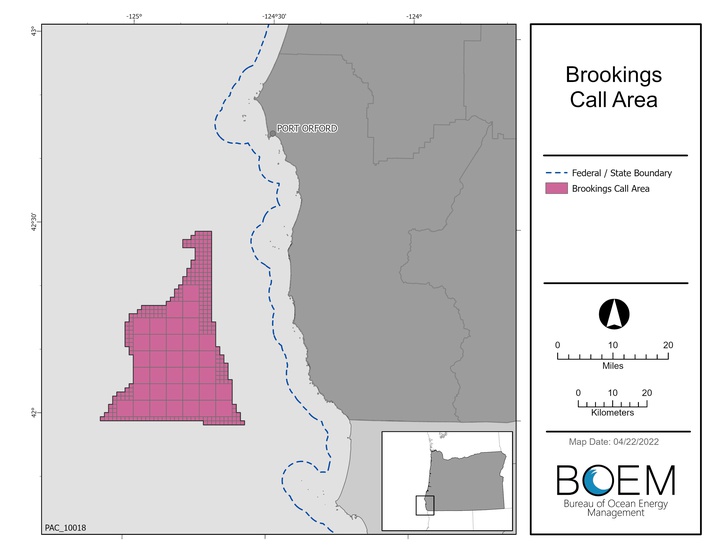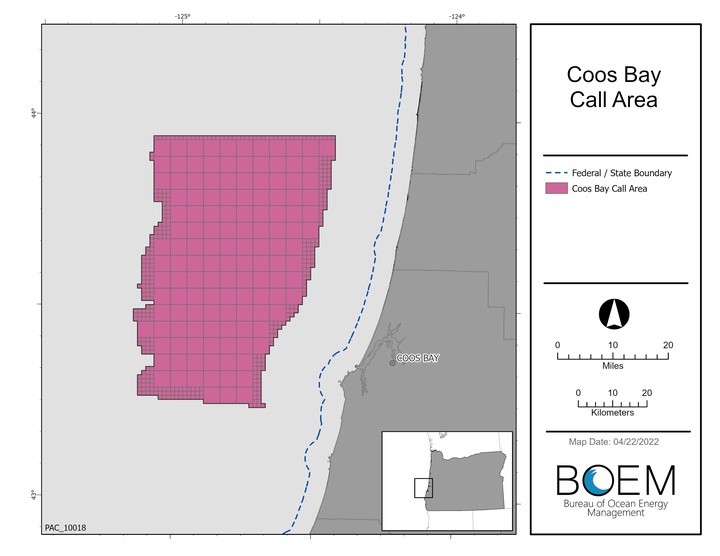Jessica Cejnar Andrews / Thursday, Oct. 12, 2023 @ 5:04 p.m.
The Brookings City Council Officially Rejects Offshore Wind Energy Development, Urges Constituents to Make Concerns Known During Presidential Election

The Brookings call area is between Gold Beach and Brookings, Oregon roughly 13.8 miles to 46 miles offshore. | Map courtesy of BOEM
Previously:
• Curry County On Offshore Wind Energy: 'No Way In Hell'
###
Despite differences that led to a recall election slated for next month, the Brookings City Council was united in its opposition to offshore wind energy development in their aquatic backyard.
Councilors on Monday unanimously approved sending a letter to the Bureau of Ocean Energy Management outlining their reasons, including potential impacts to commercial fishing, tourism and the potential harm floating wind turbines may cause to seabirds, marine mammals and other wildlife.
They welcomed Curry County Commissioner Jay Trost’s invitation to create a coastal committee in an effort to present a united front to BOEM and companies seeking to take advantage of the two Southern Oregon call areas.
Councilor Andy Martin and Mayor Ron Hedenskog also pointed out that renewable energy may be an issue brought up during the 2024 presidential election.
“If you look at what’s happened in the last couple of weeks, the governor of California just said he was fast-tracking wind energy and this plan is being fast tracked by the Biden Administration,” Martin said. “If people are concerned about it and they don’t want it to happen, when our local federal lawmakers visit Brookings you need to show up and tell them you’re against this. And when you vote, you have the chance of voting for a president or a governor who supports this or who is opposed to this. The only way to stop this, I think, is for a change in the administration.”
Councilors did ask staff to remove one statement from their letter — concerns that anchoring windmills off the Oregon coast could trigger a Cascadia earthquake.
"That may be too much of a stretch," Councilor Ed Schreiber said. "I don't want the text to come out looking like we're reaching for excuses."
The City Council’s rejection of offshore wind energy development comes about two weeks after BOEM representatives held open houses in Gold Beach, Coos Bay and Brookings.
BOEM is focused on two call areas, one about 13.8 miles offshore from Coos Bay and the other about 13.8 miles offshore from Gold Beach and Brookings. According to a Wind Energy Area Siting Analysis, development in federal waters off the Oregon coast could be important to supporting the Biden-Harris Administration’s efforts of generating 30 gigawatts of offshore wind by 2030.

The Coos Bay call area starts 13.8 miles and extends to 65 miles offshore from Charleston, Oregon. | Map courtesy of BOEM.
Oregon also approved legislation that requires investor-owned utilities and electricity providers to be 100 percent greenhouse gas free by 2040.
Meanwhile, California Governor Gavin Newsom signed a bill into law that fast tracks offshore wind deployment. Authored by State Sen. Mike McGuire, who represents the North Coast including Del Norte County, the Offshore Wind Expediting Act eliminates five years off the permitting timeline.
According to the Wind Energy Area Siting Analysis, the Brookings Call Area begins about 13.8 miles offshore and extends to about 46 miles offshore. Water depth ranges from 394 to 5,020 feet. The area stretches about 46 miles from north to south and 22 miles east to west comprising about 284,444 acres.
The Coos Bay Call Area also begins about 13.8 miles offshore extending to about 57 miles offshore, according to the analysis. Water depth ranges from 394 to 5,184 feet. The area stretches about 50 miles north to south and 35 miles east to west, comprising about 872,854 acres.
On Monday, Trost told Councilors that his colleagues appointed him to BOEM’s Oregon Intergovernmental Renewable Energy Task Force. He said he wanted to create a “coastal committee” to present a united voice to BOEM.
“This is going to be a long drawn-out slow moving process,” he said. “I would like to set the table for some future conversations and what we can look at in terms of creating a coastal committee and joining forces with Coos Bay and some of the (other) communities up there.”
Like Martin, Councilor Isaac Hodges said it’s “who you vote for” that matters when trying to prevent something he says is harmful for the environment in general. Hodges agreed with Trost in wanting to present a united front, pointing out that gaining traction is important.
“The louder our voice gets, the more they’re going to hear it,” he said. “While I’m supportive of letters, and I think they’re very important, I’m also extremely supportive of uniting, even if we have other political differences. Uniting in a solid front with a loud voice will be helpful in this situation.”
Hedenskog noted that local opposition to offshore wind energy development has a constant since he and his colleagues outlined their own concerns in a June 2022 resolution. The Brookings mayor said any development was discussed as being up to 60 miles off shore, but during BOEM’s open houses that distance suddenly dwindled to 18 miles.
“They had some projected graphics to show what it would look like if you were looking due west from Harris Beach,” Hedenskog said. “In my opinion it appeared to look like the skyline of New York City.”
Hedenskog brought up the roughly 1,500 skilled laborers federal officials say are required to build the floating wind turbines, saying Brookings doesn’t have the housing or infrastructure to house that many people.
However, he pointed out that offshore wind energy development is a Biden Administration priority that could change next year.
“I want to think back about three years ago when we changed presidencies and immediately the new administrator, president, came in and he canceled a whole bunch of executive decisions made by the prior president,” Hedenskog said. “I have no doubt in my mind that if we change administrations in approximately another year and a few months, this’ll be another one that gets canceled. That’ll leave us all sitting here scratching our heads wondering why we got so upset.”
Despite Curry County and Brookings’ opposition, members of a joint powers authority in Del Norte County are exploring whether offshore wind energy development can be a local economic driver.
Brian Stone, who represents the Crescent City Harbor District on the Tri-Agency Economic Development Authority board, said the Brookings Call Area has some of the highest wind speeds off the Pacific coast.
According to Stone, who says he’s been “working on this thing” for roughly seven years, California has designated Crescent City an operations and maintenance port. Between 50 and 100 people would be needed to tend the floating wind farm if it does sprout up in the Brookings Call Area, he said, and the Crescent City Harbor would provide space for the tugs, cranes and other vessels needed to ferry those folks to those platforms.
“Our harbor is not just this little postage stamp thing where the breakwaters are,” Stone insisted. “We’re 4,300 acres of water and land surface. We go all the way out to Nickel Creek next to the national park and we go a mile out into the ocean. This is a deepwater port. If you go out a mile, you’re sitting at a 138-foot depth or more. To float a wind turbine, you only need 38 feet of water.”
District 3 Supervisor Chris Howard, Del Norte County’s representative on the Tri-Agency board, said Curry County’s and Brookings’ opposition to offshore wind energy could impact the joint powers authority’s stance. Howard pointed out that the Tri-Agency is newly reborn and its members are still trying to figure out a work plan for the next few years.
“Where the Tri-Agency spends its time still needs to be discussed,” Howard told the Outpost. “And first and foremost is getting some staffing so we can move forward with whatever (we think) is important.”
CLICK TO MANAGE